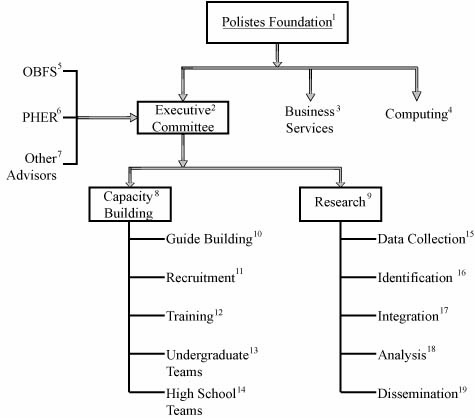#
Project Management Plan
Here we describe project management and workflow.
An asterisk* after an individual's name indicates that there is a corresponding letter of collaboration.
-
Polistes Foundation (see Project Description 4.1.5.1)
This 501c-3 organization is the Primary Institution. The PI is President and CEO. Weick is Executive Director and CFO.
-
Executive Committee (see Project Description 4.1.5.2)
The PI and Co-PI's make up the executive committee that will coordinate the network's
activities, making all decisions by rough consensus.
Pickering and LeBuhn will co-chair the Science and Analysis Sub-committee;
Stephenson and Zerega will co-chair the Taxonomy Sub-committee;
Nagy will chair the Outreach and Education Sub-committee,
and Pickering will chair the Technology Sub-committee.
Executive Committee members will attend professional meetings to coordinate our network's activities with the
larger scientific community. The Executive Committee will lead our initial workshop7
and will coordinate our activities via monthly Skype conference calls.
The Executive Committee will seek advice from others by
working with OBFS,5 PHER,6 and other advisors,7 who will serve on our sub-committees.
Working with Lowe, they will provide quarterly and annual scientific reports to the NSF.
-
Business Services (see Project Description 4.1.5.1)
Weick and Talmadge will oversee finances and provide administrative support.
They will provide fiduciary reports and audits as required by the NSF.
-
Computing (see Project Description 4.1.1 and Data Management Plan)
The PI and Discover Life staff will provide computing support,
through funding from USGS (Simpson*).
-
OBFS (see Project Description 4.1.5.3)
We will use meetings of OBFS, of which Co-PI Nagy is on the board of directors,
to recruit new field stations to the network.
Field station directors who join the network will identify faculty mentors at their sites.
We will invite these individuals to join PHER and appropriate sub-committees.
-
PHER (see Project Description 4.1.5.4)
This center is a collaboration of over 75 ecologists, taxonomists and other researchers who contribute to Discover Life.
PHER members will advise the Executive Committee on the network's science plan,
provide taxonomic oversight and populate the sub-committees.
-
Other advisors (see Project Description 4.1.4 and 4.1.5.5)
We will launch and fine-tune the network with a workshop in Elmira, New York in June 2011.
At this meeting advisors will assist the executive committee in refining our science plan
and coordinating logistics. Our advisors will continue to provide input throughout the project.
They include Cassis* (plant-herbivore interactions), Gowaty* (evolution and behavior),
Hargrove* (large-scale ecological modeling) and Hubbell* (biodiversity modeling).
-
Capacity Building
This covers the workflow and people responsible for building identification guides,10
recruitment,11 training12 and data collection teams.13, 14
-
Research
This covers the workflow and people responsible for data collection,15
identification,16 integration,17 analysis18 and dissemination.19
We describe these in our Data Management Plan.
-
Guide Building (see Project Description 4.1.2.2)
Discover Life has developed guides to wildflowers, trees, and many other taxa.
Support from the USGS, NSF and other sources will enable us to complete these guides
and customize them for local sites. We seek funding from the NSF for Beeching to complete a guide to
lichens (Buck*, Harris*, Luecking*), a technician to work with Co-PI Stephenson on slime molds and fungi,
and a graduate student to work with Co-PI Zerega on plants.
We will also enlist the assistance of the following taxonomists:
Murrell* (plants), Davison* (mosses), von Konrat* (liverworts), Brown* and Hogue* (flies), and Ascher* (bees).
We are in the process of updating existing guides to amphibians with Maerz and Pierson.
Parmer will have primary responsibility for building and resolving the local identification guides.
-
Recruitment (see Project Description 4.1.3.1; 4.1.3.2)
Lowe will coordinate and oversee the recruitment of mentors, teachers and students. Members of OBFS will assist her
in recruiting undergraduate students. Mueller* at the UGA College of Education
and Guerrero* at Cedar Shoals High School will recruit high school AP Biology teachers.
High school teachers will recruit students from their county.
UGA's Young Scholars Program will assist by recruiting high school participants (Walcott*).
-
Training (see Project Description 4.1.3.1; 4.1.3.2)
Lowe, Parmer, the PI and Co-PI's will train faculty mentors and high school teachers at regional training sessions.
Faculty mentors and high school teachers will in turn train the students in their teams.
We will supplement training sessions and mentoring with web pages and videos.
Lowe will produce these materials, and Swecker* will assist with video editing.
-
Undergraduate Teams (see Project Description 4.1.3.1 and Data Management Plan 16)
At each site faculty mentors will oversee two undergraduate students.
Under the supervision of their mentors and with the assistance of site naturalists,
students will take photographs, upload them to Discover Life,
and edit time, place and other associated information.
They will identify each image to the most specific possible taxon,
enabling taxonomic interns to find and identify them further.
Each undergraduate will serve as a taxonomic intern
and gain expertise in identifying roughly 100 species.
They will edit albums and identify species in their area of expertise.
Taxonomic experts10 will oversee all identifications.
-
High School Teams (see Project Description 4.1.3.2)
Each teacher will oversee a team of three students.
Students will collect moth images at their own houses and other data at sites in their county.
Teachers will accompany their students on initial visits to field sites.
-
DATA COLLECTION (see Data Management Plan 15)
-
IDENTIFICATION (see Data Management Plan 16)
-
INTEGRATION (see Data Management Plan 17)
-
ANALYSIS (see Data Management Plan 18)
-
DISSEMINATION (see Data Management Plan 19)

